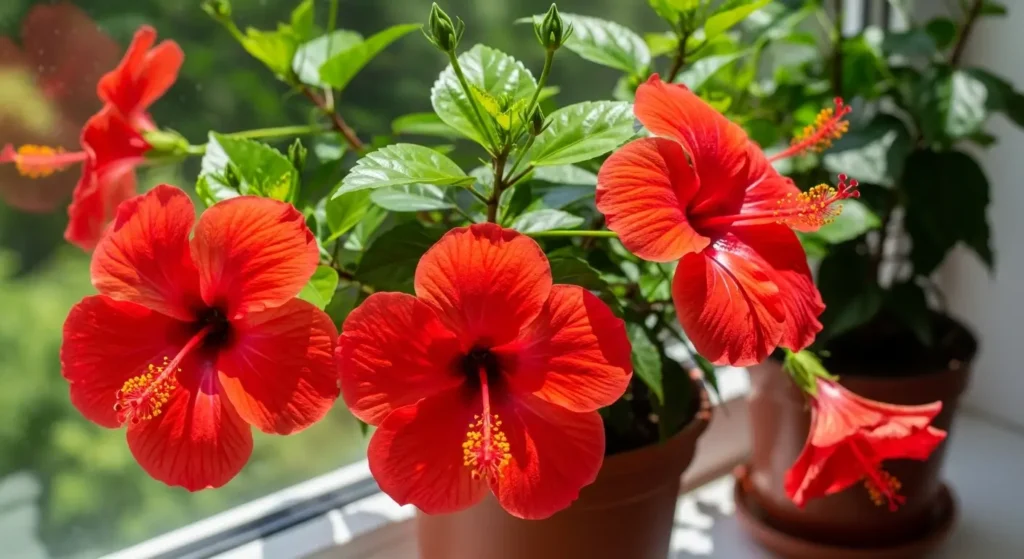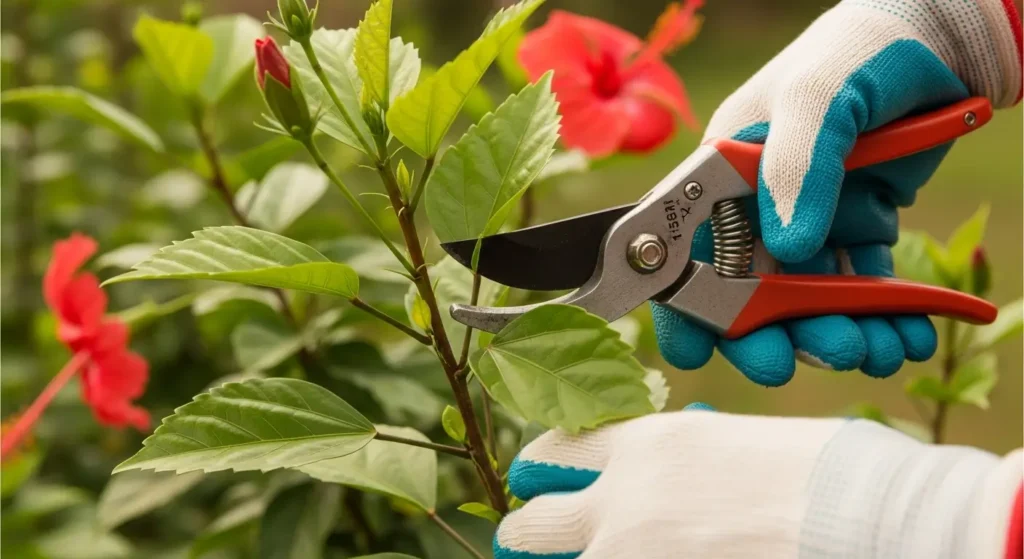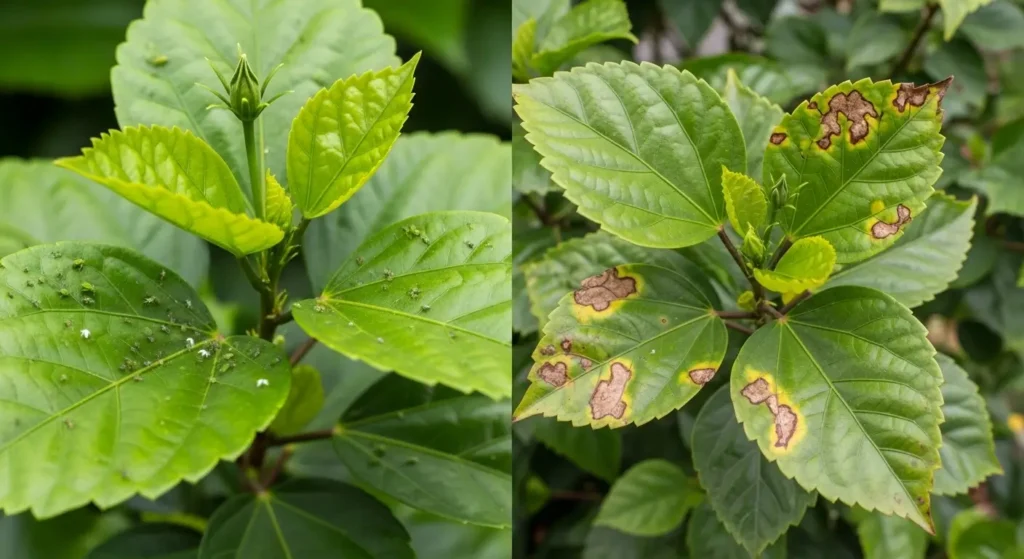
Table of Contents
If you’ve ever spotted a vibrant red or pink flower that practically screams “look at me,” you were likely admiring a japa plant. Also known as Chinese hibiscus (Hibiscus rosa-sinensis), this tropical beauty is famous for its stunning trumpet-shaped blooms in red, pink, orange, and yellow. It grows moderately fast, reaching 4-10 feet tall. This sun-lover needs 6+ hours of bright light and consistently moist soil. Good news for pet parents: it’s generally non-toxic to cats and dogs.
Japa Plant Care
Let’s face it keeping your japa plant thriving isn’t rocket science, but it does need some specific conditions to really show off those gorgeous blooms. Understanding proper care is essential for success with this tropical beauty. Here’s everything you need to know about maintaining a healthy, flowering plant.
Light
Your japa plant is basically a sun worshipper. It needs at least 6 hours of direct sunlight daily to produce those show-stopping flowers. If you’re growing indoors, place it near a south or west-facing window. Outdoors? Pick the sunniest spot in your garden.
Skimp on the light, and you’ll get lots of green leaves with barely any blooms. Light intensity directly affects flowering—without adequate sunlight, the plant focuses on survival rather than blooming. More sun equals more flowers!
Water
Here’s where many people mess up: watering. The japa plant likes its soil consistently moist but never waterlogged. Check the top 1-2 inches of soil with your finger. If it feels dry, it’s time to water. During blooming season and hot summer months, you’ll need to water more frequently.
Come winter or when the plant goes dormant, dial it back. Overwatering leads to root rot, while underwatering causes wilting and flower drop. Use room-temperature water when possible, and always make sure excess water can drain away freely.
Soil
Your japa plant isn’t picky about much, but it’s definitely particular about soil. It needs well-draining, slightly acidic soil with a pH between 6.0 and 6.8.
Rich, organic matter is your friend here when growing a japa plant. I mix peat moss, perlite, and compost in equal parts, and my plants absolutely love it. You can also grab a good quality potting mix and add extra perlite for drainage.
Whatever you do, avoid heavy clay soils that hold water like a bathtub. Good drainage is non-negotiable for japa plant success. If water sits around the roots too long, you’re inviting root rot to the party—and nobody wants that guest.
Temperature and Humidity
The japa plant is tropical through and through, so it thrives in warm temperatures between 60-90°F. It cannot handle frost or anything below 50°F. If you live somewhere with cold winters, bring it indoors or treat it as an annual.
Humidity is another big deal. These plants prefer levels around 50-70%, which can be tricky indoors during winter. Keep a humidifier running nearby, mist the leaves regularly, or set the pot on a pebble tray filled with water.
Fertilizing Schedule
During the growing season (spring through fall), your japa plant is hungry. Feed it every 2-4 weeks with a balanced fertilizer like 10-10-10, or use a bloom-boosting formula for maximum flower power. Potassium-rich fertilizers are particularly great for promoting gorgeous blooms.
When winter rolls around and growth slows down, reduce or stop fertilizing altogether. One word of caution: don’t overdo it. Too much fertilizer causes leaf burn and can actually reduce flowering. When in doubt, go lighter rather than heavier.
Types of Japa Plant
You’ll love the variety available when it comes to the japa plant. There’s truly something for everyone, whether you prefer classic single blooms or fancy double-flowered varieties.
Single-flowered japa plant types have the traditional five-petaled look that most people picture when they think “hibiscus.” These are absolutely stunning in their simplicity. Meanwhile, double-flowered varieties pack multiple layers of petals, creating fuller, more dramatic blooms that look almost like roses.
Color options for the japa plant are endless:
- Red varieties: The classic choice and most traditional color
- Pink and coral: Soft, romantic, and utterly gorgeous
- Yellow and orange: Bright, cheerful, and tropical
- White: Elegant and sophisticated, often with colorful centers
- Bi-color: Two-tone beauties that really turn heads
Some of my favorite japa plant cultivars include ‘Brilliant’ with its bright red flowers, ‘Cooperi’ which has gorgeous variegated foliage with pink and red leaves, and ‘Crown of Bohemia’ featuring double golden-yellow blooms. The White Hibiscus Plant ‘White Wings’ is particularly striking with its pure white petals and red center.
Don’t forget about dwarf japa plant varieties if you’re working with limited space. These compact beauties are perfect for containers and small gardens. And if you’re curious about unusual colors, check out the Blue Hibiscus Plant, though technically it’s a different species with similar care needs.
Flowers on a mature japa plant typically range from 4-8 inches across, and honestly, the bigger the bloom, the more dramatic the statement.
Pruning

Pruning Your Japa Plant
Pruning might sound intimidating, but it’s actually one of the best things you can do for your hibiscus. The ideal time for major pruning is early spring before new growth starts. Throughout the year, remove dead, damaged, or diseased branches whenever you spot them.
For heavy pruning, cut back about one-third of the plant to encourage bushier growth. Use clean, sharp pruning shears and make cuts at a 45-degree angle above leaf nodes. Deadhead spent blooms regularly to keep flowers coming and promote continuous blooming.
Here’s what to do when pruning your japa plant:
- Use clean, sharp pruning shears (dirty tools spread disease)
- Make cuts at a 45-degree angle just above leaf nodes
- Deadhead spent blooms regularly to keep flowers coming
- Shape the plant as you go—bush, small tree, or hedge form
The benefits are real. Pruning your japa plant promotes branching, increases flower production, maintains a manageable size, and improves air circulation around the plant. Just don’t go overboard and remove too many flower buds, or you’ll be waiting a while for the next bloom cycle.
After pruning, give your japa plant a good drink and apply some balanced fertilizer to support new growth.
Propagating Japa Plant
Want more japa plants without spending money? Propagation is your answer, and it’s easier than you might think.
Stem Cutting Method (Most Common)
This is my go-to method for propagating japa plant because it’s straightforward and has a high success rate. Take 4-6 inch cuttings from healthy stems, making your cut just below a leaf node at a 45-degree angle.
Strip off the lower leaves from your japa plant cutting, keeping only 2-3 sets at the top. Dip the cut end in rooting hormone—this step is optional but seriously boosts your success rate. I never skip it.
Plant the cutting in moist potting mix or simply place it in a glass of water. Keep it in a warm, bright spot with indirect light. According to research from the University of Florida’s IFAS Extension, stem cuttings typically develop roots in 4-8 weeks under proper conditions.
Once roots are 2-3 inches long, transplant into soil. Honestly, watching those tiny roots develop is oddly satisfying.
Air Layering Method
This technique is a bit more advanced but works great for larger branches on your japa plant. Select a healthy branch still attached to the plant and make a small wound in the bark. Apply rooting hormone, then wrap the area with moist sphagnum moss.
Cover everything with plastic wrap to keep the moss moist. In 6-8 weeks, roots should form. Cut below the rooted section and pot it up. Boom—new plant.
Seed Propagation
This is the least common method for growing japa plant because it takes longer and seedlings might not look like the parent plant. But if you’re patient, collect seeds from dried seed pods, soak them for 24 hours, and plant in seed-starting mix. It’s a fun experiment, even if it’s not the most reliable route.
Potting and Repotting Japa Plant
Choosing the right container makes a huge difference. Always pick pots with drainage holes—non-negotiable. Go 2-4 inches larger than the current root ball. Use well-draining, nutrient-rich potting mix with added perlite for best results.
Repot every 2-3 years or when roots grow through drainage holes. The best time is early spring before active growth. Water the day before, gently remove the plant, trim dead roots, and place in fresh soil. Skip fertilizing for 4-6 weeks after repotting.
When to repot your japa plant:
- Every 2-3 years for established plants
- When roots grow through drainage holes
- If growth slows significantly
- When water drains through too quickly
The best time to repot a japa plant is early spring before active growth kicks in. Water your plant the day before repotting to make the process easier on the roots.
Gently remove your japa plant from its current pot, loosen the root ball, and trim any dead or circling roots. Place it in the new pot with fresh soil, water thoroughly, and keep it in shade for a few days while it recovers.
Skip fertilizing for 4-6 weeks after repotting. The fresh soil has plenty of nutrients, and you don’t want to stress the plant further. Some temporary wilting is normal—don’t panic.
Common Pests and Diseases

Let’s talk about the uninvited guests that sometimes show up on your japa plant. Regular inspection is your first line of defense.
Common Pests
Aphids are tiny insects that cluster on new growth, sucking sap and leaving sticky residue. Blast them off with water or treat with insecticidal soap.
Spider mites are sneaky little pests that cause stippled, yellowing leaves. You might see fine webbing too. Increasing humidity helps, and neem oil works wonders for control.
Whiteflies are exactly what they sound like—small white flying insects that scatter when you disturb the plant. Yellow sticky traps catch them effectively.
Mealybugs look like tiny cotton balls stuck to stems and leaves. Remove them with a cotton swab dipped in rubbing alcohol.
Scale insects appear as small brown bumps on stems. Scrape them off manually or use horticultural oil for severe infestations.
Common Diseases
Leaf spot is a fungal issue causing brown or black spots on leaves. Improve air circulation and remove affected leaves promptly.
Root rot happens when soil stays too wet for too long. Prevention is key—water less and make sure drainage is excellent.
Powdery mildew creates a white, powdery coating on leaves. Treat with fungicide and improve air flow around the plant.
Bacterial blight causes wilting and dark lesions. Remove infected parts immediately and dispose of them (not in compost).
The best approach? Prevention. Keep your plant healthy with proper care, maintain good air circulation, and inspect regularly. Neem oil works as both treatment and preventative measure for many issues.
Common Issues with Japa Plant
Even with great care, problems pop up with the japa plant. Here’s how to troubleshoot the most common complaints.
Yellowing Leaves
This usually means your japa plant is getting overwatered, suffering from nutrient deficiency, or not getting enough light. Check your watering schedule first—it’s the most common culprit. If the soil is soggy, let it dry out more between waterings. If the plant needs more light, move it to a brighter spot. A dose of balanced fertilizer might help if nutrients are the issue.
Flower Bud Drop
Nothing’s more frustrating than watching buds form on your japa plant, only to have them drop before opening. This typically happens due to stress from temperature changes, inconsistent watering, or low humidity. The solution? Maintain stable conditions and stick to a consistent care routine. Your plant will reward your reliability.
No Blooms
If your japa plant is all leaves and no flowers, look at light first. Insufficient sunlight is the number one reason for lack of blooms. Over-fertilizing with nitrogen-heavy fertilizers also causes leafy growth at the expense of flowers. Switch to a bloom-boosting formula with higher phosphorus and potassium.
Brown Leaf Tips
Low humidity, fluoride in tap water, or salt buildup in soil can all cause brown, crispy leaf tips. Increase humidity around the plant, switch to filtered or rainwater, and flush the soil periodically to remove salt accumulation.
Wilting Despite Moist Soil
This is concerning because it usually signals root rot, pest infestation, or transplant shock. Check the roots for mushiness or bad smell. Inspect carefully for pests. If you recently repotted, give your plant time to adjust—it should bounce back in a week or two.
Leggy Growth
When your japa plant gets leggy with long stems and sparse leaves, it’s not getting enough light. Move it to a brighter location and prune it back to encourage bushier growth. More light equals more compact, attractive growth.
Leaf Drop
Sudden leaf drop usually means environmental stress—cold drafts, sudden temperature changes, or being moved frequently. Hibiscus doesn’t like surprises. Stabilize its conditions and avoid moving it around unnecessarily.
FAQ
Who should not drink hibiscus tea?
Pregnant women, people on blood pressure medication, and those scheduled for surgery should avoid hibiscus tea as it can lower blood pressure and affect blood sugar levels.
What is the spiritual benefit of hibiscus?
The japa plant symbolizes beauty, devotion, and feminine energy in many cultures. It’s used in Hindu worship and believed to attract positive energy, prosperity, and good fortune to the home.
What is the English name for hibiscus?
The most common English names are Chinese hibiscus, shoe flower, and tropical hibiscus. The scientific name Hibiscus rosa-sinensis means “rose of China.”
What organ is hibiscus good for?
Hibiscus is particularly beneficial for heart and liver health. It may help lower blood pressure, reduce cholesterol, and support liver detoxification. Always consult your doctor before medicinal use.
